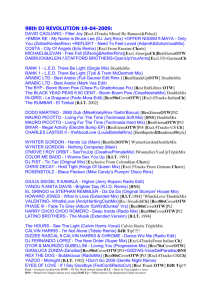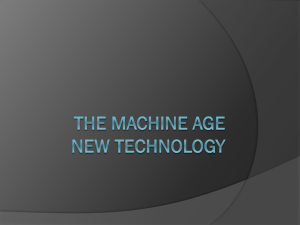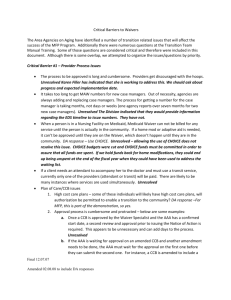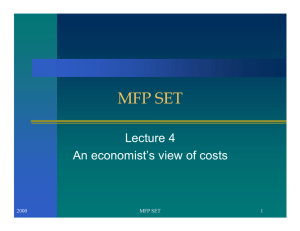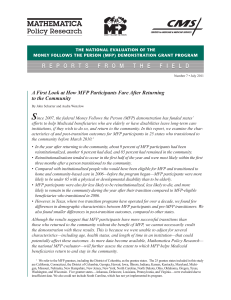Productivity Paradox Presentation
advertisement
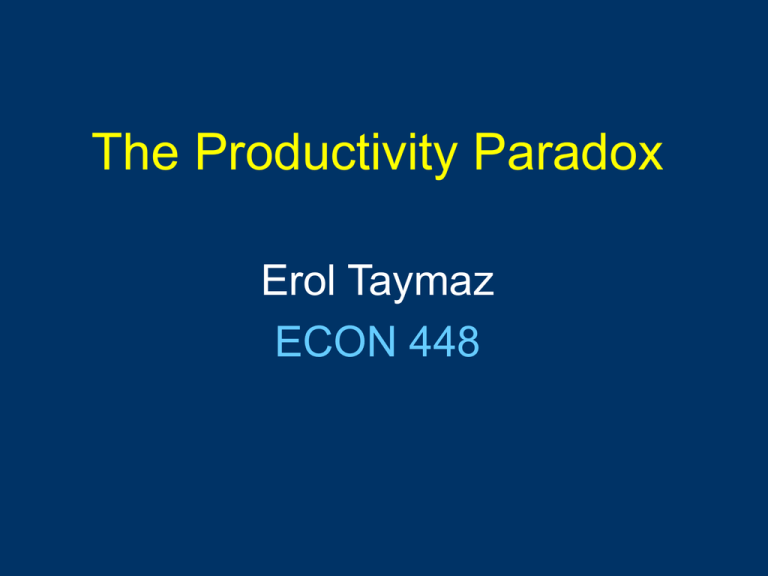
The Productivity Paradox Erol Taymaz ECON 448 The Paradox • We Love Computers • Computers (Seem To) Hamper Productivity: “we see computers everywhere but in the productivity statistics.” (Solow-paradox) 2 The Paradox ICT investment TFP growth 3 Evidence of a Problem 2.5 2 1.5 1 0.5 0 1870-1913 1913-1950 1950-1973 1973-1993 Productivity Growth Slump, 1973 - present 4 Evidence of a Problem (part 2) Value Added • Productivity = Person-Hour Employed • Downturn in Productivity Growth, not Productivity 5 Evidence of a Problem (part 3) • Massive Expenditures in Information Technology – 43% of capital budgets on hardware alone • Has Replaced Other Forms of Capital Investment – but hasn’t performed as well – some studies show a zero return on investment for IT, vs. ~13% for traditional investments 6 Why (not)? • Service Industries’ Output Hard to Quantify – Banking: labor output = labor input – Baily and Gordon: attempted to correct for poor measurements, could only raise growth 0.2% • Unmeasured Value – What if lots of value added with no dollar increase? • Cars now have airbags, better emissions, antilock brakes... – BLS figures uses strict dollar amounts 7 Excuses • Too early to tell [Oliner and Sichel, 2000] – Computer Hardware is only 2-5% of capital stock – Technology still immature – Insufficiently trained workforce • Major innovations (PCs, the Internet, etc) have been generated since the mid 1990s 8 Other Explanations • What we observe is substitution of IT for non-IT, there is no technical change [Jorgenson and Yip, 2001] • It is not a great innovation (compared to the early 20th century) [Gordon, 2000] 9 Technical Change in IT 10 Technical Change in IT Relative Pricesof ComputersandSemiconductors, 1977-2000 All price indexes are divided by the output price index. 1,000 Log Scale (1996=1) 100 10 1 0 0 1977 1982 1987 Computers 1992 Memory Logic 1997 11 IT’s Share in Output Growth Industry Contribution to Value Added 4.5 Average annual percentage growth rates, weighted by the value share. 4.0 Annual Contribution (%) 3.5 3.0 2.5 2.0 1.5 1.0 0.5 0.0 1977-1989 1989-1995 Non IT IT 1995-2000 12 IT’s Share in Output Growth Industry Contributions to Value Added Growth, 1977-2000 Household Wholesale Trade Finance Professional and Social Svcs. Computers and Office Equipment Retail and Eating Real Estate (rental) Electronic Components Business Svc excl. Computer Government excl. Education Health private Other Services Agriculture Communications Computer Services Government Education Transportation Food and Tobacco Rubber and Plastic Electricity Government Enterprises Instruments and Miscellaneous Mfg. Communications Equipment Chemicals Printing and Publishing Legal Lumber, Wood, Furniture Fabricated Metal Other Transportation Equipment Paper Education, private Construction Textiles, Apparel, Leather Other Electrical Mach Insurance Motor Vehicles Stone, Clay, Glass Coal Mining Primary Metal Non Energy Mining Machinery excl. Computers Petroleum Refining Gas Oil and Gas Mining -0.1 0 0.1 0.2 0.3 0.4 0.5 0.6 13 IT’s Share in Capital Input Capital Input Contribution of Information Technology Average annual percentage growth rates, weighted by income 2.50 Annual Contribution (%) 2.00 1.50 1.00 0.50 0.00 1977-1989 1989-1995 Non-IT Capital Services IT Capital Services 1995-2000 14 IT’s Share in Capital Input Industry Contributions toCapital Input Growth, 1977-2000 Household Finance Wholesale Trade Business Svc excl. Computer Professional and Social Svcs Communications Government excl. Education Computer Services Retail and Eating Real Estate (rental) Insurance Machinery excl. Computers Printing and Publishing Government Enterprises Transportation Health private Other Services Electricity Instruments and Legal Chemicals Electronic Components Government Education Oil and Gas Mining Communications Equipment Food and Tobacco Other Transportation Construction Gas Fabricated Metal Computers and Office Other Electrical Mach Motor Vehicles Rubber and Plastic Stone, Clay, Glass Paper Textiles, Apparel, Leather Lumber, Wood, Furniture Primary Metal Agriculture Education, private PetroleumRefining Non energy Mining Coal Mining -0.05 0.00 0.05 0.10 Note: Industries sorted by ITcapital contribution. 0.15 0.20 0.25 0.30 0.35 0.40 0.45 ITCapital Non-ITCapital 15 Sources of US Growth Sourcesof U.S. EconomicGrowth 4.5 4.0 3.5 3.0 2.5 2.0 1.5 1.0 0.5 0.0 1977-1989 1989-1995 1995-2000 -0.5 Labor Non-ITCapital ITCapital TFP 16 Sources of US Growth Sources of Growth in Industry Output, 1977-2000 Agriculture Non Energy Mining Coal Mining Oil and Gas Mining Construction Lumber, Wood, Furniture Stone, Clay, Glass Primary Metal Fabricated Metal Machinery excl. Computers Computers and Office Other Electrical Mach Communications Equipment Electronic Components Motor Vehicles Other Transportation Equipment Instruments and Miscellaneous Food and Tobacco Textiles, Apparel, Leather Paper Printing and Publishing Chemicals Petroleum Refining Rubber and Plastic Transportation Communications Electricity Gas Wholesale Trade Retail and Eating Finance Insurance Real Estate (rental) Computer Services Business Svc excl. Computer Health private Legal Education, private Professional and Social Svcs. Other Services Government Enterprises Household Government excl. Education Government Education -5 0 5 Intermediate 10 Labor 15 Capital Productivity 20 25 17 Sources of Growth in DCs Sources of Economic Growth by Country 5.0 4.0 3.0 2.0 1.0 0.0 -1.0 -2.0 1980- 1989- 19951989 1995 2000 US 1981- 1989- 19951989 1995 2000 1980- 1989- 19951989 1995 2000 Canada UK Labor Non-IT Capital 1980- 1989- 19951989 1995 2000 France IT Capital 1980- 1989- 19951989 1995 2000 1980- 1989- 19951989 1995 2000 Germany Non-IT Productivity Italy 1980- 1989- 19951989 1995 2000 Japan IT Productivity 18 Substitution of IT for non-IT 19 Growth Accounting • Oliner and Sichel (2000) • Growth accounting dY = acdKc + asdKs + amdKm + aodKo + aL(dL + dq) + MFP 20 Table 1. Contributions to Growth of Real Nonfarm Business Output, 1974-99 1974-90 3.06 1991-95 2.75 1996-99 4.82 0.49 0.27 0.11 0.11 0.86 1.16 0.22 0.33 0.57 0.25 0.25 0.07 0.44 0.82 0.44 0.48 1.10 0.63 0.32 0.15 0.75 1.50 0.31 1.16 Income shares: Hardware Software Communications eqmnt Other capital Labor hours 1.00 0.80 1.50 27.90 68.90 1.40 2.00 1.90 26.80 67.90 1.80 2.50 2.00 26.70 66.90 Growth rates of inputs Hardware Software Communications eqmnt Other capital Labor hours 31.30 13.20 7.70 3.10 1.70 17.50 13.10 3.60 1.60 1.20 35.90 13.00 7.20 2.8021 2.20 Growth rate of output Contributions from: Information technology capital Hardware Software Communications eqmnt Other capital Labor hours Labor quality Multifactor productivity Table 2. Sectoral Contributions to Growth in Nonfarm Busines MFP 1974-90 0.33 1991-95 0.48 1996-99 1.16 0.12 0.08 0.13 0.17 0.16 0.12 0.20 0.23 0.26 0.39 0.50 0.49 Output shares Computer sector Semiconductor sector Other nonfarm business 1.10 0.30 98.90 1.40 0.50 98.80 1.60 0.90 98.70 Growth of MFP Computer sector Semiconductor sector Other nonfarm business 11.20 30.70 0.13 11.30 22.30 0.20 16.60 45.00 0.51 Growth rate of nonfarm business MFP Contribution from each sector Computer sector Semiconductor sector Other nonfarm business Computer sector plus computer-related semiconductor sector 22 Growth Accounting • A sharp increase in MFP • IT capital plays an important role; both its use and production • The impact will stay relatively strong for at least the next few years • Its share increased, so does its effect 23 Does the “New Economy” Measure up to the Great Inventions of the Past? Gordon (2000) 24 A New Growth Accounting 25 Structural Acceleration in MFP 26 Structural Acceleration in MFP • The “New Economy” does not reach to other, non-IT sectors, that produce 80% of output. • 1995-1999 is too short. The MFP growth may reflect cyclical effects. 27 Questions? • Why was growth so slow after 1972? • Why was growth so fast during the “Golden Years” 1913-1972? 28 The Great Inventions of the 2nd IR • Electricity – Electric light and electric motor – Electric chair EM revolutionized manufacturing • New consumer goods • Air conditioning 29 The Great Inventions of the 2nd IR • Internal combustion engine made possible personal autos ICE led to • • • • Suburbs Highways Supermarkets No rural isolation 30 The Great Inventions of the 2nd IR • Chemicals, plastics, and pharmaceuticals • New materials • Longer life expectancy – 1900-1950, increased by 0.72% per year – 1950-1995, increased by 0.24% per year 31 The Great Inventions of the 2nd IR • Entertainment, communication and information • • • • • • • Telegraph (1844) Telephone (1876) Phonograph (1877) Popular photography (1880s) Radio (1899) Motion pictures (1880s) TV (1911) 32 The Great Inventions of the 2nd IR • Urban infrastructure • Running water • Indoor plumbing • Urban sanitation 33 The Great Inventions of the 2nd IR • Would you like to live in a house without a flush toilet or the Internet? 34 What about the future? • Do we expect an increase in MFP as a result of the diffusion of the New Economy, the Internet, etc? No! 35 Why not? • Diminishing returns... We already received most of the benefits of these innovations. 36 Then, why firms invest in IT? • Market share protection (Barnes and Noble vs Amazon – a zero-sum game) • Recreation of old activities rather than creation of new activities (much internet content...) • Duplication • Use of business computers for consumption purposes 37



